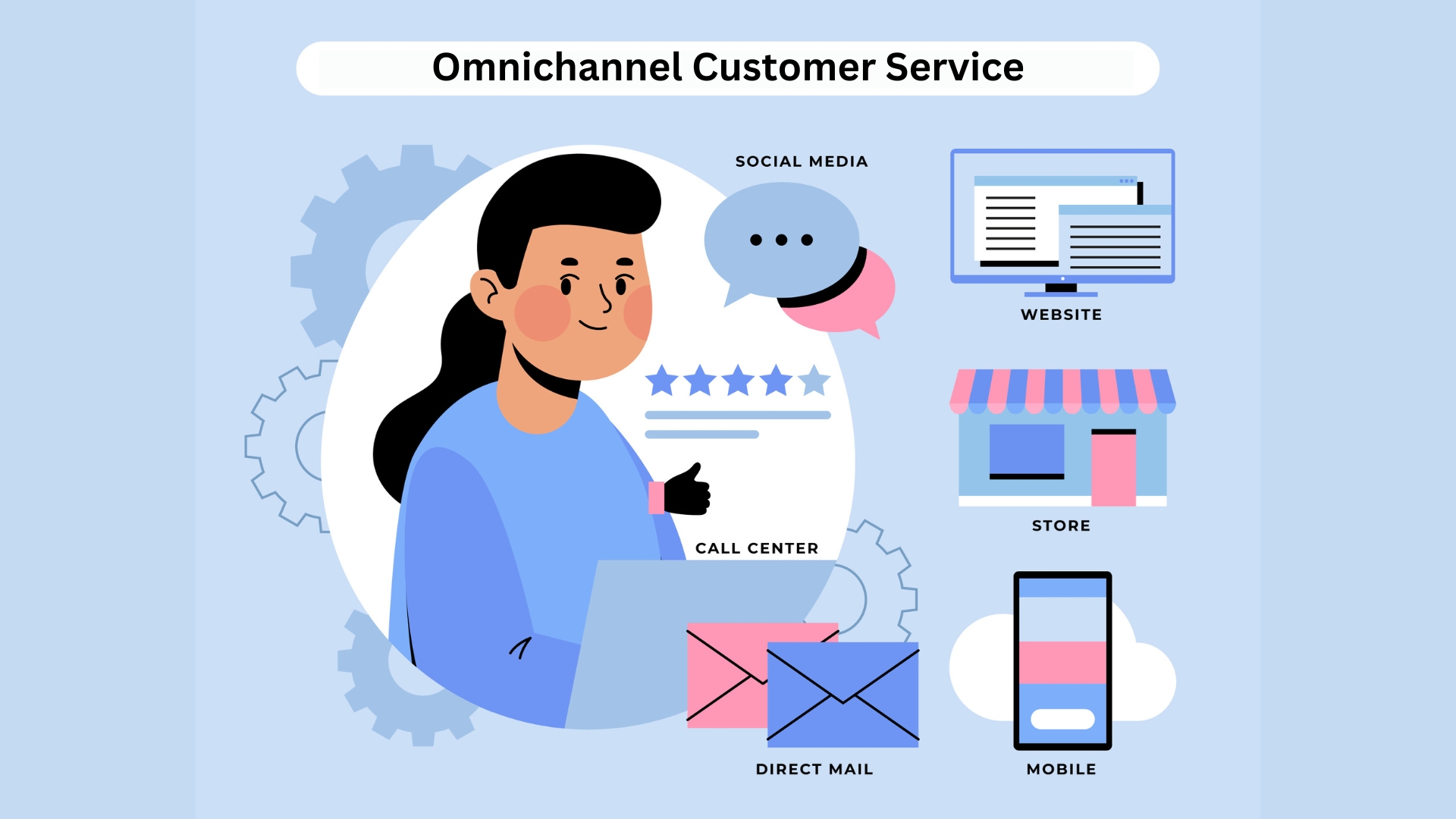In today’s digital era, a staggering 3.6 billion people actively use social media platforms, making it the go-to channel for customers to interact with their favorite brands. With the growing demand for instant and personalized customer service, businesses must leverage social media as a vital component of their omnichannel customer service strategy.
We’ve closely analyzed how social media impacts omnichannel customer service, and today you’ll learn how it can boost the client’s experience and the best practices for using social media for better customer relationships.
By the end of this article, you will gain insights into why social media is essential for modern customer service and learn practical strategies to elevate your brand’s reputation and customer satisfaction.

What Is Omnichannel Customer Service
Omnichannel customer service is the art of delivering seamless, consistent, and personalized customer support across various touchpoints and communication channels. This dynamic approach transcends the limitations of traditional customer service methods, which often focus on a single channel, such as phone, email, or live chat support.
At the heart of omnichannel customer service lies the concept of interconnectedness. It aims to create a synchronized and cohesive support model where all communication channels work harmoniously and simultaneously.
Moreover, this integration allows customer inquiries from multiple channels to merge into a single stream, equipping support agents with the necessary context to provide an exceptional customer experience.
We cannot overstate the importance of social media in customer service in today’s climate. As a vital component of omnichannel support, social media platforms empower businesses to offer real-time assistance and foster meaningful connections with their customers.
Businesses should also add contact forms on their website, so their customers can easily reach out for any problems or questions.
What Impact Does Social Media Have on Omnichannel Customer Service?

Social media has become an integral part of omnichannel customer service, transforming how businesses connect with their customers. Although leveraging social media for customer service presents unique challenges, we cannot ignore its numerous advantages.
What Are the Benefits of Using Social Media?
In terms of benefits, effective social media customer service can result in public acknowledgment of positive experiences, improving a company’s reputation and credibility.
Additionally, studies indicate that customers tend to spend 20-40% more with companies that respond to their service requests on social media. Businesses that engage with customers on social platforms experience a 15% lower churn rate than those that don’t.
Which Social Media Platforms Do Businesses Use for Customer Service?
There are several common social media platforms that businesses use for customer service, each with its own characteristics. Twitter, for example, has a diverse age demographic and requires concise, friendly messaging while maintaining a high presence of influencers, regulators, and authorities.
On the other hand, Facebook encourages casual interactions and rewards companies with a “very responsive” badge when they meet specific response time criteria. LinkedIn, being more formal, sees higher engagement for B2B posts and demands a professional writing approach.
What Are the Limitations of Social Media?
Despite the evident benefits, businesses face limitations when using social media for customer service. One challenge lies in the varying expectations of customers across different platforms. Each platform has its unique user base and demographics, necessitating businesses to adjust their tone, formality, and response times accordingly.
Furthermore, customers expect rapid responses to their queries and complaints on social media, and meeting these expectations can be demanding, with only around 50% of businesses currently doing so.
Another challenge is the unpredictable nature of demand spikes on social media channels, which can be influenced by various factors, such as marketing campaigns, regulatory changes, and new product launches.
Lastly, businesses often face skill gaps in social media servicing, requiring different skills than traditional service channels. Also, the rapid increase in demand has made it difficult for organizations to hire staff with previous experience in social media servicing.
Are Chatbots a Better Option for Social Media?

The rapid growth of social media usage has allowed businesses to improve customer service, engagement, and marketing efforts.
As more brands turn to chatbots for live-chat customer support, it’s essential to consider the advantages and drawbacks of this approach in comparison to traditional customer service channels.
The Benefits of Using a Chatbot
Chatbots bring numerous benefits to social media customer service. They allow businesses to be present on multiple platforms, catering to customers’ preferences and providing a convenient online experience.
Moreover, chatbots can provide 24/7 support, ensuring customer inquiries are addressed promptly, even outside of operating hours. By using AI-powered chatbots, companies can build stronger customer relationships through personalized interactions while streamlining processes and reducing costs.
Additionally, chatbots can serve as an effective marketing tool, promoting offers, capturing leads, and gathering valuable customer data. Today, you can even use Chaty to create a chat button on your website that will connect you to your customers on their preferred channels.
The Challenges of Using a Chatbot
However, there are challenges when implementing chatbots for social media support. Ensuring a seamless transition between chatbot and human-agent interactions is critical for maintaining customer satisfaction.
Striking the right balance between automation and the human touch can be difficult, but it is necessary for delivering exceptional customer experiences. Furthermore, choosing the appropriate chatbot type (rule-based or AI-powered) based on business needs is crucial for success.
Finally, chatbots should proactively initiate conversations, offer multilingual support, and have a unique personality that reflects the brand to engage customers effectively.
What’s the Best Option for Your Company?
Businesses should focus on hiring people or implementing AI-powered chatbots into their social media customer support strategy for a truly effective omnichannel service.
Humans can connect with others quickly and build a relationship faster than a chatbot. However, humans are not as fast as an AI chatbot.
AI live chat bots offer advanced capabilities such as natural language processing and machine learning, enabling them to deliver more human-like and personalized interactions. Moreover, this enhances the overall customer experience and promotes stronger relationships with the brand.
Best Practices for Using Social Media in Omnichannel Customer Service

Effectively integrating social media into your omnichannel customer service strategy is crucial for providing exceptional customer experiences. By following these best practices, you can boost your social media customer support and improve your brand’s reputation.
Tips for Integrating Social Media into Customer Service
Embracing social media as a customer service channel is essential. Let us show you some valuable tips for seamlessly integrating it into your omnichannel strategy.
Centralize customer data: To provide personalized and consistent support, it’s essential to have a centralized system that consolidates customer data from various sources.
Moreover, this includes interactions with sales, comments on your blog, website browsing history, and demographic information. Having a unified view of customer data can deliver relevant and targeted support across all channels.
Use the right tools: Choose social media management tools that help streamline your customer service processes, allowing your team to respond to inquiries quickly and efficiently. Look for features such as automated replies, keyword filtering, and analytics to measure your success.
Train your team: Ensure your customer service team is well-versed in social media etiquette and best practices. They should understand the specific tone, language, and style appropriate for each platform and be able to provide consistent service across channels.
Importance of Monitoring Social Media Channels
By monitoring social media channels, you can gain valuable insights into customer emotions and identify trends or issues that your business must address. This process allows you to improve proactively and demonstrate your commitment to customer satisfaction.
Here are two steps that your business needs to take:
- Regularly monitor social media channels for customer inquiries, feedback, and mentions of your brand.
- Actively engage with customers by quickly responding to their questions and comments, demonstrating that you value their input and are committed to providing exceptional service.
Tips for Dealing with Negative Feedback on Social Media
There’s no company out there that doesn’t receive negative feedback. However, what you do with that makes all the difference for the success of your business. Here are the best two strategies that can help you in these situations:
Respond promptly and professionally: Address negative feedback quickly and respectfully. Apologize for any inconvenience and offer a solution or assistance to resolve the issue. This approach demonstrates that you take customer concerns seriously and want to improve their experience.
Learn from criticism: Use negative feedback to identify improvement areas and enhance your products, services, and customer support. By embracing constructive criticism, you can demonstrate your commitment to continuous growth and development.
Implementing these best practices will allow you to successfully integrate social media into your omnichannel customer service strategy, encouraging stronger relationships with your customers and improving their overall experience with your brand.
Final Thoughts
Social media has revolutionized the customer service landscape, making it a vital component of any successful omnichannel strategy. To provide exceptional support, businesses must embrace the interconnectedness of various communication channels, add custom contact form fields, and harness the power of social media.
Companies can enhance their brand reputation and customer satisfaction by integrating social media effectively and implementing best practices. Additionally, learning from negative feedback and using AI-powered chatbots or actual people can further improve customer experiences and promote stronger relationships with the brand.
As the digital world continues to evolve, businesses that adapt and prioritize social media in their omnichannel customer service approach will better position themselves to meet the ever-changing expectations of modern customers.


